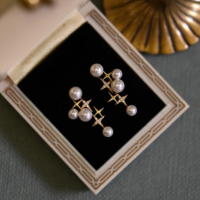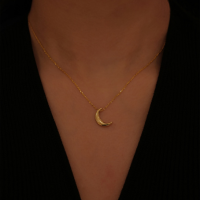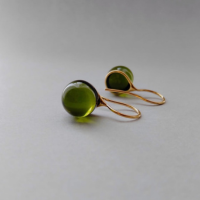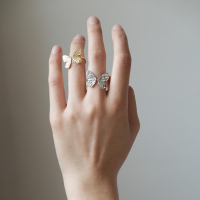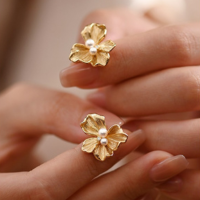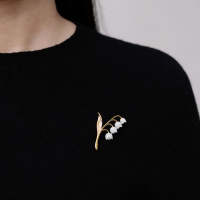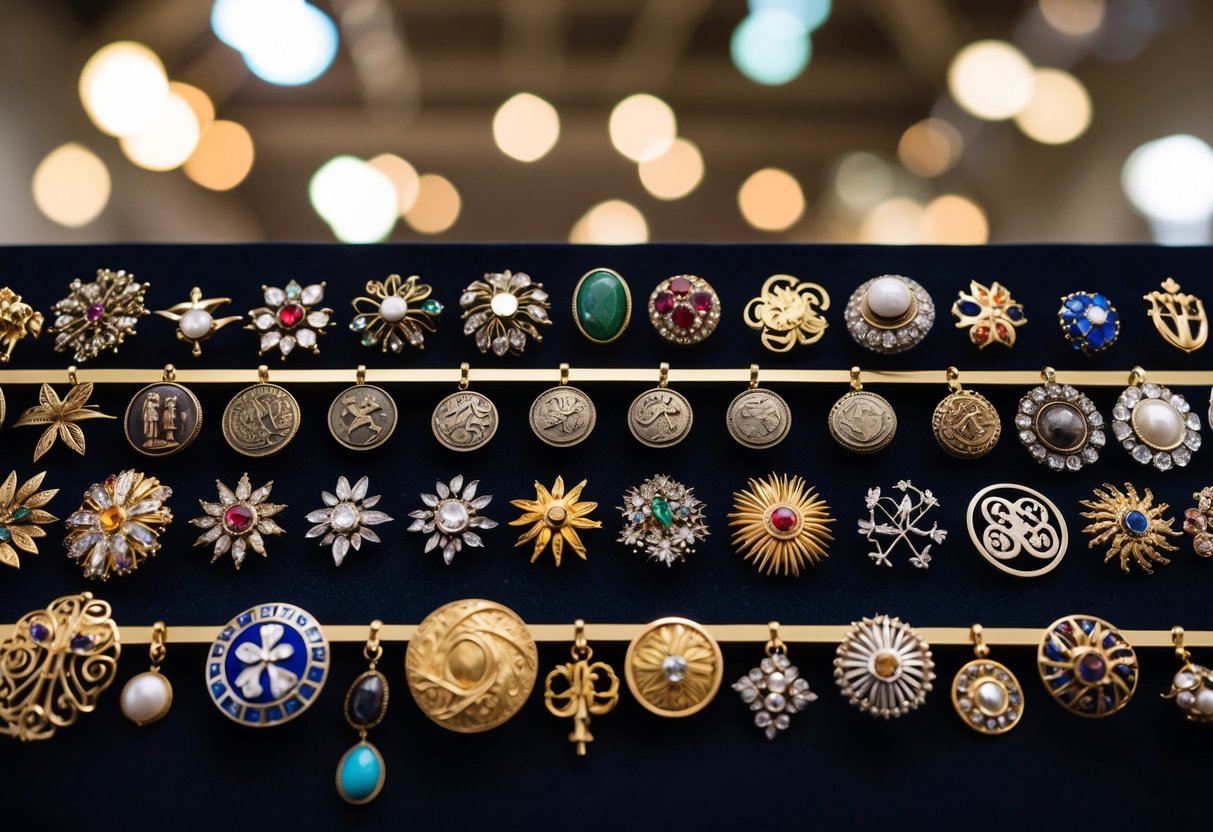
Brooch Symbolism Through History: What Your Brooch Says About You
Check out our personalized jewelry collections! (kids drawing jewelry, coin jewelry, wire jewelry, fingerprint jewelry, handwriting jewelry, and more)
Brooches have been more than just decorative pieces throughout history. They tell stories, show social status, and express personal style. As a small piece of jewelry, a brooch can hold deep meanings.
Understanding what your brooch represents can offer insight into your personality and values.
From ancient times to modern fashion, brooches have played a role in cultural and social symbolism. Different regions have adopted them for various reasons, such as showing membership in a group or representing love and protection. These changes over time highlight their continued relevance and adaptability.
The materials and designs of brooches often showcase the wearer's status and personal taste. Whether simple or extravagant, each brooch reflects something unique about its owner. It’s fascinating how these little pieces can make such a big impact.
Key Takeaways
- Brooches symbolize personality and status.
- They have held various cultural meanings throughout history.
- Design and material choices reflect personal expressions.
Origin and Evolution of Brooches
Brooches have a rich history that dates back thousands of years. These decorative pieces were first used in the Bronze Age. They started as simple pins to hold clothes together. Over time, brooches became more ornate and served as symbols of status.
As we moved through history, the Romans and Greeks added more intricate designs. Gold, silver, and gemstones were introduced during this time. Brooches began to signify wealth and power among wearers. They were not just functional but became key fashion pieces.
In the Middle Ages, brooches continued to evolve. They were often crafted with religious symbols, reflecting personal beliefs. We saw the use of enamel and intricate carvings, adding more artistry to these pieces. During the Renaissance, brooches became even more intricate, combining artistry with meaning.
The Victorian era brought a huge change to brooch design. Personalization became popular, with brooches often containing portraits or locks of hair. They became sentimental items, connecting wearers to loved ones. This period also saw the rise of mourning brooches, worn to honor the deceased.
Today, brooches are celebrated as versatile fashion statements. They continue to reflect personal style and can transform any outfit. As we appreciate their beauty and function, it's clear that brooches have traveled a long and interesting journey.
Cultural Significance Across Regions
Brooches have held various meanings and roles in different cultures. Let’s explore their significance from ancient times to the modern day.
Ancient Civilizations
In ancient Egypt and Greece, brooches were more than ornaments. They fastened clothing, showing status and wealth. Egyptian brooches often depicted gods and used materials like gold and stones. These pieces acted as protection symbols and talismans.
Greek designs were simpler, using bronze and silver. Brooches showed community ties and beliefs about the afterlife. They often included motifs like animals or mythical creatures. The Greeks valued the functionality and beauty of brooches, blending practicality with artistic expression.
Medieval Europe
Medieval Europe saw brooches as symbols of power and faith. Nobles and church officials used them to display rank. Styles varied, from intricate metalwork to colorful enamel designs.
Religious motifs were common, as the church played a big role in daily life. Brooches featured crosses or saints, acting as both decoration and spiritual protection. Materials like gold, silver, and precious stones indicated the wearer’s wealth and status.
These brooches were not just adornments; they were statements of one’s faith and prestige.
Victorian Era
The Victorian era embraced brooches as sentimental tokens. They were used to memorialize loved ones and commemorate events. Brooches made of hair or featuring portraits were popular.
Queen Victoria’s influence made these pieces fashionable and widespread. Mourning brooches, in particular, became part of societal norms. They often included black enamel or jet stones, representing loss and remembrance.
Victorian brooches reflected personal stories and societal trends, merging emotion with elegance.
Contemporary Interpretations
Today, brooches serve both as fashion statements and personal expressions. Designers experiment with materials—think plastics, metals, and fabrics. The focus is on individuality and creativity.
People use brooches to personalize outfits, add flair, and showcase interests. They are not restricted to particular occasions or social classes. Brooches are versatile, bridging past traditions with modern trends.
We see them on casual wear or evening attire, proving their lasting appeal and adaptability in the world of fashion.
Material and Design: A Reflection of Status
When we look at brooches, the material used is often a sign of status. Gold and silver were common among the wealthy. Both metals are still seen as symbols of luxury today. In the past, only the elite could afford brooches with precious gems.
Gemstones used in brooches send strong messages. Diamonds, rubies, and emeralds were especially popular. Their presence often signified wealth and power. Today these stones continue to be coveted in our collections.
The design of a brooch also tells a story. Elaborate designs with intricate details often belonged to nobility. Simple shapes might have been worn by the middle class or those who preferred understated elegance.
We can trace cultural influences through brooch design. Some brooches include motifs like flowers or animals. Others feature family crests or symbols with specific meanings. These details contributed to the status message the brooch conveyed.
Materials and designs changed with technology, too. Advances in crafting techniques allowed for more refined designs. This made brooches accessible to more people over time. Today, we have endless choices in materials and styles.
By studying these aspects of brooches, we can gain insights into the society that used them. In the world of fashion jewelry, our choices in material and design continue to make statements about who we are.
Symbolic Meanings of Common Brooch Motifs
In our exploration of brooch motifs, we'll discover how floral designs speak to renewal, animals symbolize personal traits, geometric patterns carry hidden harmonies, and figurative elements tell stories of identity and belief. Each motif offers a unique insight into historical and cultural significance.
Floral Designs
Floral brooches have been loved for their natural beauty and deep meanings. Roses, for example, often stand for love and passion. Lilies might symbolize purity and renewal.
These motifs connect us to nature and have been used in jewelry throughout history. Different cultures give unique meanings to each flower.
Victorian brooches often included forget-me-nots, which meant remembrance. Meanwhile, daisies can symbolize innocence. Flower designs also feature in Art Nouveau, with elegant, sinuous lines that mimic natural forms. It's fascinating how these delicate pieces can speak volumes about the wearer's emotions and sentiments.
Animals and Insects
Animal motifs in brooches connect us to the natural world. Butterflies symbolize transformation and change. Lions often represent courage and strength.
Birds, like doves or eagles, might show peace or liberty. These designs reflect personal traits and aspirations.
Insects, such as bees or beetles, bring in ideas of hard work and resilience. Victorian times saw jewelry adorned with dragonflies and bees, hinting at the fleeting nature of life. These motifs allow wearers to express their inner world and desires through charming creature symbols.
Geometric Patterns
Geometric patterns in brooches captivate with their symmetry and order. Shapes like circles or squares hold symbolic value.
In ancient cultures, circles might symbolize eternity or unity. Triangles can point to balance and creativity.
Art Deco designs often featured intricate geometric shapes, highlighting a love for modernity and precision. These patterns can tell stories of harmony and precision. When we wear these brooches, we connect with both history and contemporary style.
Figurative Elements
Figurative brooches tell stories using human-like designs. Cameos featuring profiles of people or mythological figures invite us to discover personal or mythic tales.
Some designs might include hands holding objects, symbolizing loyalty or faith. Other pieces may show mythic symbols like Greek gods or historical figures.
These brooches serve as a canvas for the wearer’s personal story or identity. During the Renaissance, such designs mirrored the fascination with humanism. Today, we see them as timeless connections to art, history, and our collective heritage.
Personal Expression Through Brooches
Brooches have allowed us to express our political views, show romantic feelings, and remember important events or people. Each brooch can hold and share a different story.
Political Statements
Brooches have often been used to convey strong political messages. Think of how they've been worn during important movements or campaigns. For instance, suffragettes used brooches to support women's right to vote. These brooches often featured colors and symbols representing their cause.
Today, they continue to be a tool for making statements. Activists might wear brooches to show alignment with causes like climate change or human rights. The brooch becomes a quiet voice, speaking to those who notice it.
Romantic Sentiments
A brooch can be a perfect token of love and affection. They are unique gifts that often hold sentimental value. Lovers have exchanged brooches to express their feelings. Victorian-era brooches frequently featured romantic motifs like hearts or entwined initials.
Such pieces carry deep personal meaning and can become cherished family heirlooms. When we wear a brooch given by a loved one, it serves as a reminder of that special bond. These pieces are often passed down through generations, carrying stories of love and connection.
Commemorative Pieces
Brooches often help us mark significant milestones or remember special occasions. These include military awards, family mementos, or celebration of events. The design and symbols in the brooch can capture the essence of what they commemorate.
At times, they honor the memory of loved ones. Memorial brooches might incorporate locks of hair or photographs. By wearing a commemorative brooch, we keep these memories alive. Each piece tells a personal story that connects us to our past, reflecting moments worth remembering.
Wearing Brooches: Tips and Etiquette
Brooches add a special touch to outfits, whether for a casual look or a formal event. Understanding key aspects like placement and how to mix brooches with other jewelry helps enhance our style.
Placement and Attire
Placement is key when wearing brooches. Typically, they are pinned on the left side near the shoulder. It's important to ensure the fabric can support the brooch's weight without sagging. For a classic look, placement on jackets, blazers, or coats works beautifully.
For lighter fabrics, consider less bulky brooches. This avoids potential damage to delicate materials. Don't hesitate to use brooches on hats or even a handbag for an interesting twist. Choose designs and styles that match the occasion, be it a formal meeting or a casual gathering.
Combining with Other Jewelry
When combining a brooch with other jewelry, balance is important. Avoid wearing overly intricate earrings, necklaces, or bracelets with a statement brooch. Instead, opt for simple designs that complement rather than compete.
Matching materials can create harmony. For example, pair a silver brooch with silver earrings or a gold one with a gold chain. It's all about creating a cohesive look. By selecting jewelry items that work well together, we maintain a stylish and polished appearance.
Caring for Your Brooches: Preservation and Upkeep
Brooches can be more than just accessories; they are pieces of art. To keep them looking their best, we need to take proper care of them. Here are some tips to preserve and maintain your brooches.
Storage
Store brooches in a soft pouch or a separate box. Use a lined jewelry box to prevent scratches. We should keep them away from direct sunlight and humidity.
Cleaning
Use a soft cloth to wipe your brooches after wearing them. For a deeper clean, use mild soap and water. Avoid harsh chemicals. It’s best to dry them immediately with a soft towel.
Handling
Handle brooches with clean, dry hands. Be gentle when fastening and removing them. Avoid dropping them on hard surfaces, as this can damage delicate parts.
Materials Care Table
| Material | Care Tip |
|---|---|
| Gold/Silver | Polish occasionally with a soft cloth |
| Gemstones | Check settings regularly |
| Pearls | Keep away from perfumes and hairspray |
Regular Inspection
Inspect brooches often. Check for loose stones or clasps and take them to a jeweler if repairs are needed.
Custom Pieces
For custom jewelry, follow any special care instructions provided. Custom pieces might have unique care needs due to specific materials or designs.
Collecting Brooches: A Hobby and Investment
Collecting brooches is more than just a love for jewelry. It's an adventure through time. We find treasures from different eras and styles. There's art deco, vintage floral, and modern minimalist. These pieces tell stories and show the creativity of their times.
For enthusiasts, each brooch can be a unique expression of style. Some collectors might focus on certain themes, like animal motifs or precious gemstones. Others might gather brooches from specific designers or time periods. Each choice reflects taste and personality.
Collecting brooches can also be a smart investment. Rare pieces often appreciate in value over time. Authentic brooches with precious materials like gold or diamonds may be sought after by other collectors. We often see their value growing, especially if they're kept in good condition.
Caring for our collection is important. We should store them properly, avoiding moisture and sunlight. Using specific jewelry boxes or pouches can help keep them safe. Regular cleanings ensure they maintain their shine and charm.
Sharing our passion with others builds connections too. Engaging with fellow collectors can be both fun and educational. We can join clubs or attend jewelry fairs. There, we can exchange knowledge and perhaps find that missing piece to complete a collection.
Collecting brooches brings joy and creativity. It's a way to connect with history, express individuality, and maybe even secure an investment for the future.
Frequently Asked Questions
Brooches have captured our imaginations for centuries. Their styles, symbols, and uses tell fascinating stories about fashion and culture. We explore how to date antique brooches, understand their historical significance, and more.
What historical significance do different styles of brooches hold?
Brooches have been worn for thousands of years. Each style marks a different time period, reflecting society's tastes and technological advances. For example, Celtic brooches often used intricate knot designs, while Victorian ones might feature flowers or cameos.
How can you date antique brooches based on their clasps?
The type of clasp on a brooch can reveal a lot about its age. For instance, the C-clasp was common until the early 20th century. Later, the safety catch became popular. Observing these features helps us pinpoint the brooch's origin time.
In what periods were brooches most popular, and why?
Brooches had peak popularity during the Victorian era and the Art Deco period. In Victorian times, they were highly sentimental. By the Art Deco era, bold designs expressed modern style. These periods show how brooches adapt to cultural shifts.
What do the various symbols depicted on brooches represent?
Symbols on brooches often carried personal or cultural meanings. A heart might symbolize love, while a crown represents power. During wartime, patriotic symbols were common. Understanding these symbols helps us appreciate the thoughts and feelings of past wearers.
What cultural importance has been attached to wearing brooches throughout history?
Brooches have signified status, allegiance, and artistic expression. In ancient Rome, they showed social rank. In the Renaissance, they were a mark of wealth and refinement. Different cultures also attach their meanings, adding rich layers to their significance.
What are the recognized etiquette guidelines for adorning outfits with brooches?
Wearing a brooch can enhance any outfit. Place it on the left side, traditionally where it catches the eye. Match the brooch size to the occasion: subtle for formal events, bold for casual attire. This helps us wear brooches confidently and stylishly.

